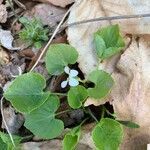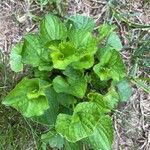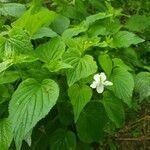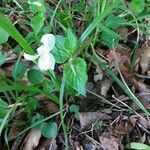Plants glabrous or nearly so, clustered, 6–30 cm, reclining or erect from a short rhizome; lower cauline and basal lvs orbicular-ovate and blunt, the upper cordate-ovate and acute, with many small teeth, all plicate-rugulose; stipules large, foliaceous, lanceolate to lance-oblong, pointed, fimbriate-toothed; fls very numerous, rising well above the lvs; sep fimbriate-ciliate, lance-linear, with pronounced basal auricles; pet cream-color or ivory, usually with brown-purple veins near the base, but not washed with anthocyanins either front or back, the lateral ones strongly bearded, the spur thick and well-developed, 3–4 mm; style slender, the tip bent; cleistogamous fls on leafy branches 2–15 cm from the lf-axils in summer; frs ellipsoid-globose, 4–5 mm; seeds pale brown; 2n=20. Usually in sun or light shade, along ditches and streams, often weedy; Mass. to Ill. and reputedly Minn., s. to Ga., Ark., and e. Okla. Apr.–June. A hybrid with no. 26 is V. ×brauniae Glover ex Cooperr. One with no. 24 [Viola conspersa Rchb.] is V. ×eclipes H. E. Ballard.
A low herb. It keeps growing from year to year. It has a short thick underground stem or rhizome. The leaves at the base turn white quickly. The leaves on the stem are simple and 3-8 cm long. They are almost round and wider near the base and with a pointed tip. There are teeth along the edge. The leaf stalk is long. The flowers are cream or white. Each flower has a slender stalk. The flowers have 5 petals with purple veins. The fruit are round capsules. These are 5-10 mm long.






